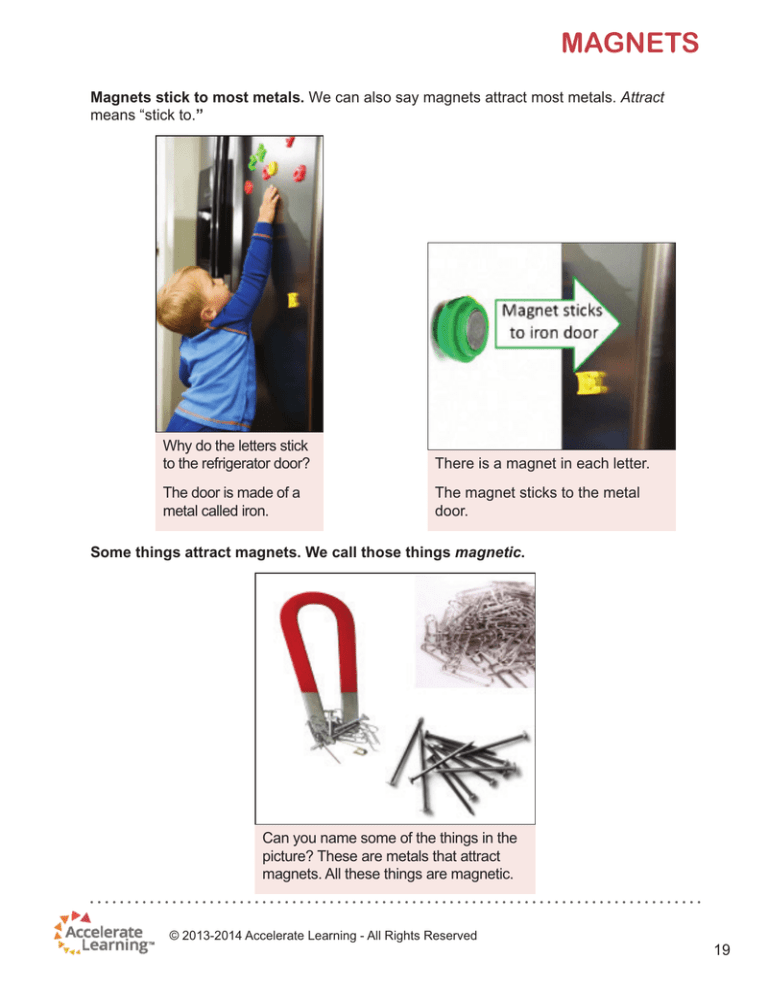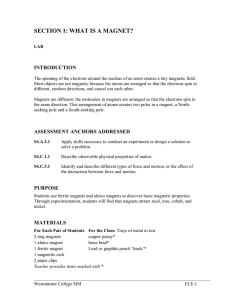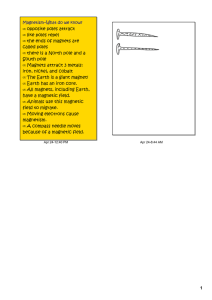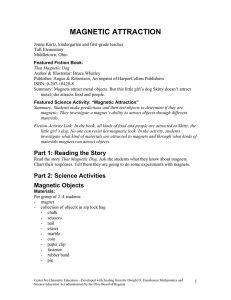
Magnets
Magnets stick to most metals. We can also say magnets attract most metals. Attract
means “stick to.”
Why do the letters stick
to the refrigerator door?
There is a magnet in each letter.
The door is made of a
metal called iron.
The magnet sticks to the metal
door.
Some things attract magnets. We call those things magnetic.
Can you name some of the things in the
picture? These are metals that attract
magnets. All these things are magnetic.
© 2013-2014 Accelerate Learning - All Rights Reserved
19
Magnets
Some things are NOT magnetic.
Not all metals are
magnetic. This can
is aluminum. It won’t
stick to a magnet.
Pennies, plastic, and wood are also
not attracted to a magnet.
Now you try! Look at the three pictures below. Which things WILL stick to a magnet?
Which things will NOT stick to a magnet? Circle your answers.
Iron paper clips
Iron screws
A rubber ball
WILL or WILL NOT
WILL or WILL NOT
WILL or WILL NOT
stick to a magnet.
stick to a magnet.
stick to a magnet.
What are two more things that are NOT MAGNETIC? Write your answers below. Test
them with a magnet to be sure.
20
© 2013-2014 Accelerate Learning - All Rights Reserved
Magnets
Every magnet has two ends.
One end of a magnet is called NORTH (N).
One end of a magnet is called SOUTH (S).
Think about putting magnets next to each other. Different things can happen.
Two magnets may attract.
Two magnets may also push apart.
What do you think is different
here?
© 2013-2014 Accelerate Learning - All Rights Reserved
21
Magnets
Look at the picture below. Two magnets are next to each other.
The same ends are next to each other.
So, the magnets push apart.
Now you try! Draw arrows to show if the magnets come together or push apart.
Opposite ends are next to each other.
The same ends are next to each other.
22
© 2013-2014 Accelerate Learning - All Rights Reserved
Magnets
connecting with your child
What’s Got Magnetic Attraction?
Help your child experience more about
magnetism by taking a magnetic tour around
your home. Give your child a magnet that
they can use to test objects around your
home. Walk through different rooms and
have them choose objects that they want
to test for magnetism. Suggestions for
magnetic surfaces include the refrigerator
door, file cabinets, dishwasher door,
whiteboards, and wrought iron fixtures such
as candlesticks, picture frames, bed posts,
and wine racks. AVOID ELECTRONICS—
ESPECIALLY COMPUTERS. Magnets can
cause serious damage to these devices.
Once your child chooses an object,
encourage them to predict whether it is
magnetic or not magnetic before testing
their hypothesis. Notice if your child begins
gravitating toward metal objects to test in
order to get positive results. If not, help them
see the pattern that magnets are attracted to
most metal materials (primarily iron, nickel,
cobalt, and non-stainless steel).
Have your child make a data table where
they can record each object they test and
note whether it is magnetic or not magnetic.
Your child can take digital pictures of all the
different objects they test and include them
in their data table, as well.
Afterward, give your child a second
magnet. See if they are able to determine
which poles of each magnet are the same
and which are different by attracting and
repelling them.
Here are some questions to discuss with
your child:
1.What kinds of things are magnetic?
2.What do you know about things that
are not magnetic?
3.What two things can happen when
two magnets come together?
Have your child make a data table where
they can record each object they test and
note whether it is magnetic or not magnetic.
Your child can take digital pictures of all the
different objects they test and include them
in their data table, as well.
© 2013-2014 Accelerate Learning - All Rights Reserved
23



